Canon RF 100-400mm f5.6-8 review
-
-
Written by Gordon Laing
Intro
The Canon RF 100-400mm f5.6-8 is a low-cost telephoto zoom designed for the full-frame EOS R mirrorless system. Announced in September 2021 alongside the RF 16mm f2.8, the RF 100-400 costs around $649 or 699 pounds and in this review I’ll show you what it can do.
Before going any further, it’s important to note where the RF 100-400 fits in Canon’s lineup. First, it’s a native RF lens which means it won’t work on EF DSLRs or the EF-M system – this is only for EOS R cameras. Secondly, it is not Canon’s mirrorless version of the hugely popular EF 100-400 f4.5-5.6L. That lens is a high-end L-series model with better build and a brighter aperture, costing $2400 in the latest Mark II version, making it almost four times the price of the RF model. If you’re looking for a high-end telephoto zoom in the native RF format, Canon’s got you covered with the RF 100-500 f4.5-7.1L, costing $2800 and I have a full review of that linked here. So the RF 100-400 is a smaller, lighter and optically dimmer lens aimed at lower budgets – more like the EF 70-300mm USM in style.
In my review below I’ll show you all of my photo, video and focus tests, but if you prefer to read a written version, keep scrolling for the highlights.
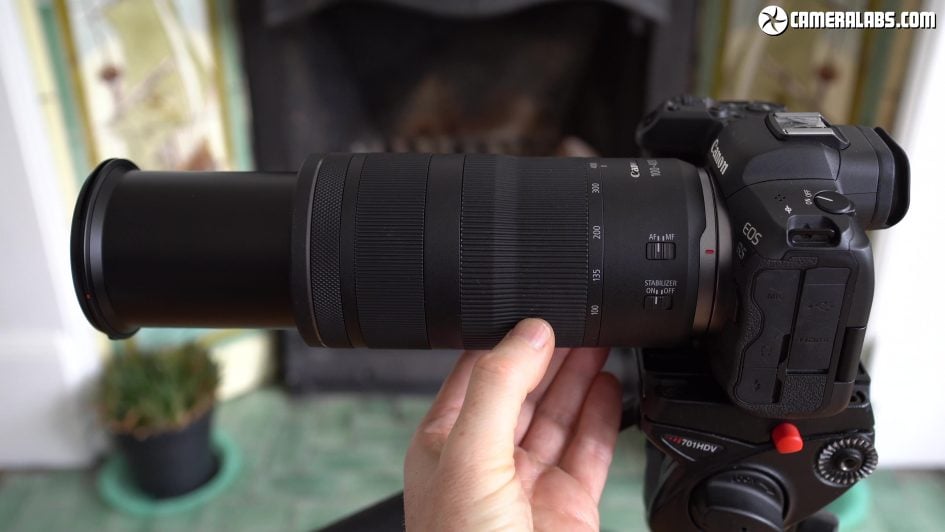
Above: The Canon RF 100-400mm weighs 635g and measures 80x165mm. Starting at the body-end, there’s a broad zoom ring that can be locked at the shortest position and which extends the barrel in one section by around 76mm when fully-zoomed to the 400mm focal length. Next to this is a smooth manual focusing ring, with a dedicated AF / MF switch so you don’t need to select MF in the menus, and finally a customisable RF control-ring. So it may be a budget lens, but at least the manual focus and RF control rings are separate and not merged into one. Finally at the end is a 67mm filter thread. Sadly like all Canon’s non-L lenses, no hood is supplied as standard. There’s no weather-sealing either, at least not at the mount-end, so if you’re using it for outdoor sports or wildlife in wet or dusty conditions, be warned.
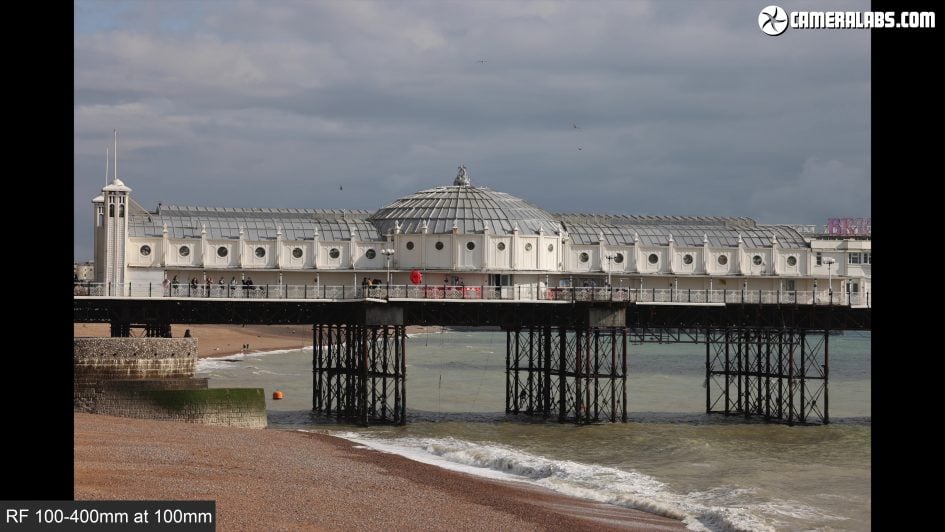
Above: Ok now to illustrate that 4x optical zoom range in practice, starting at 100mm…
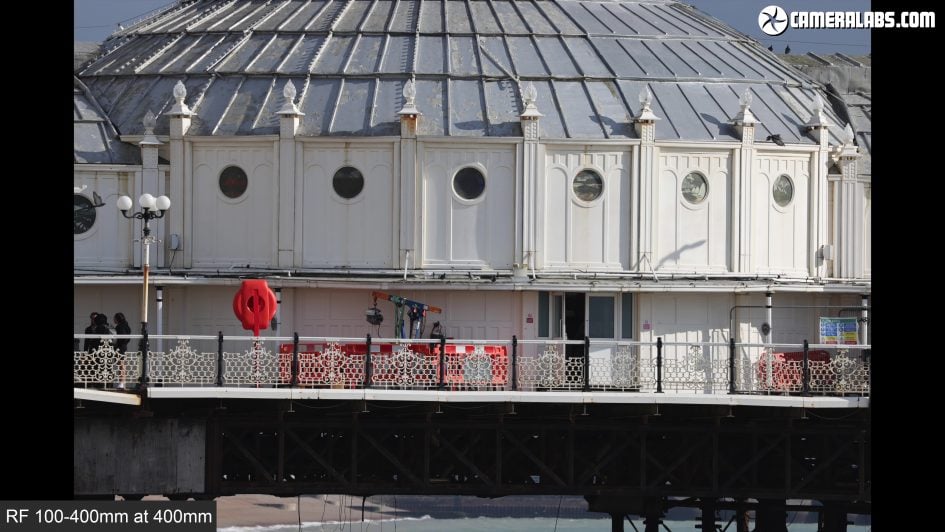
Above: before zooming to 400mm, taking you from mild to long telephoto; if you’d like more reach, the lens is compatible with the 1.4 and 2x RF tele-converters, and unlike the 100-500 they’ll work throughout the entire focal range too. Many people only think of telephoto zooms for sports or wildlife, but I also love them for landscape photography so let’s first see how the lens performs at long distances.
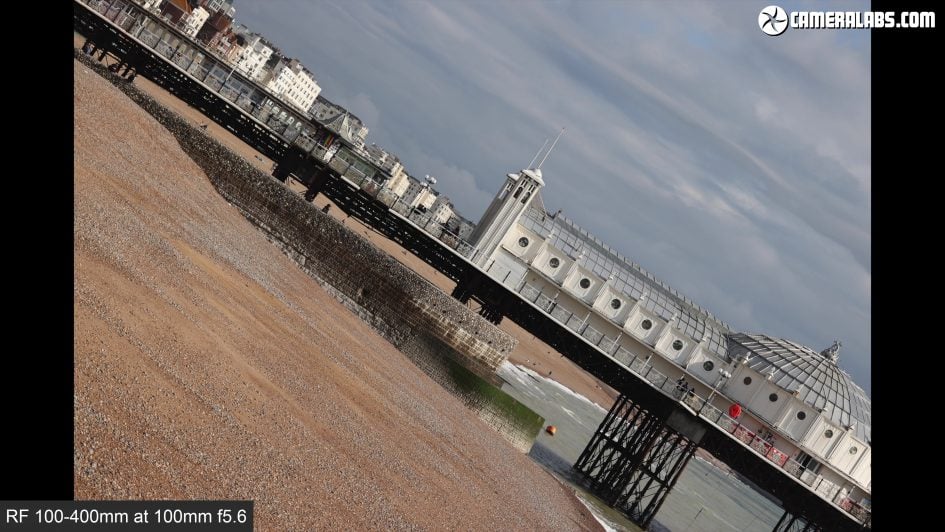
Above: Ok so here’s my side-on test view of Brighton Pier from about 200m away with the camera angled so that details run into the corners. I prefer photographing distant subjects under daylight to test a lens rather than using a chart at close range, although I also have portrait and macro tests coming up in a moment.
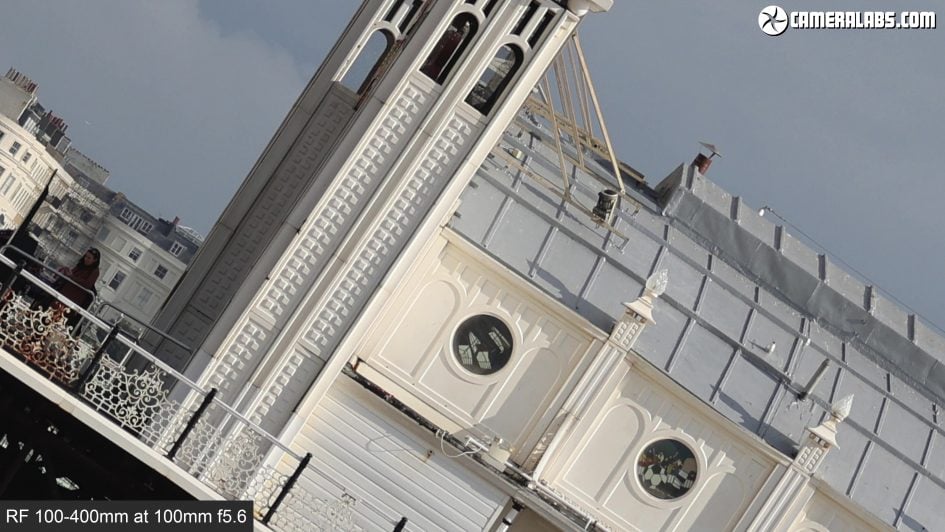
Above: This was taken at 100mm using the maximum f5.6 aperture on the EOS R5, and taking a close look in the middle shows a decent level of detail from the start. Closing the aperture to f8 or f11 made little to no difference to my results at 100mm in the middle.
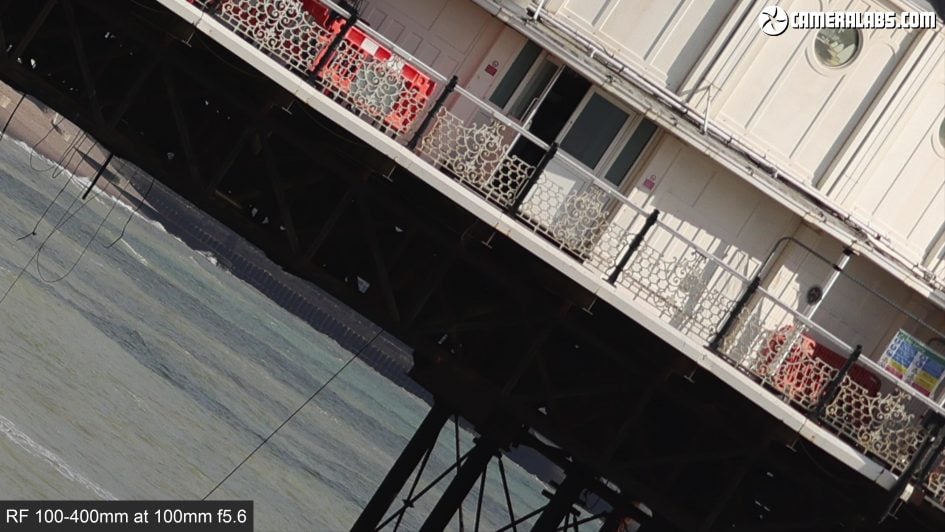
Above: Heading out to the corner at the maximum f5.6 aperture shows the lens essentially maintaining this performance with only the very slightest hint of softness or fringing if you’re really pixel-peeping. I’d be happy using it wide-open at 100mm though which is good news since the maximum aperture of f5.6 isn’t exactly bright to start with. Here’s the same image taken at f8 and now at f11 to show there’s little to be gained by closing the aperture.
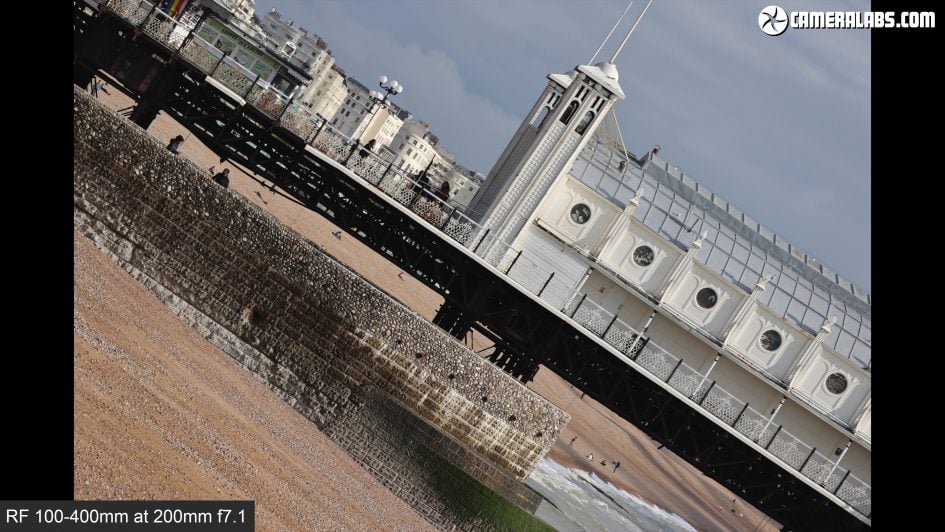
Above: Next here’s the view at 200mm, where the maximum aperture has dimmed by two thirds of a stop to f7.1.
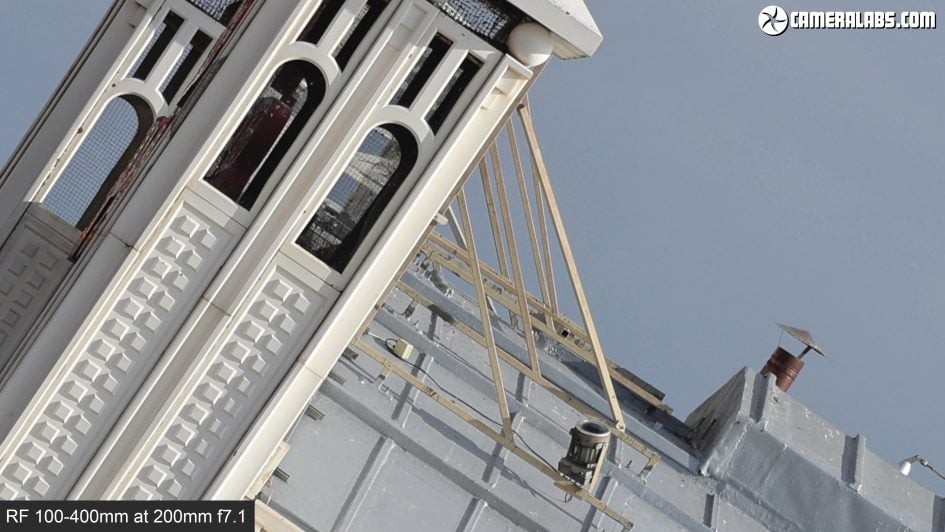
Above: Zooming-into the middle of the image once again shows very fine details with no evidence of any undesirable artefacts and again no benefit to closing the aperture any further.
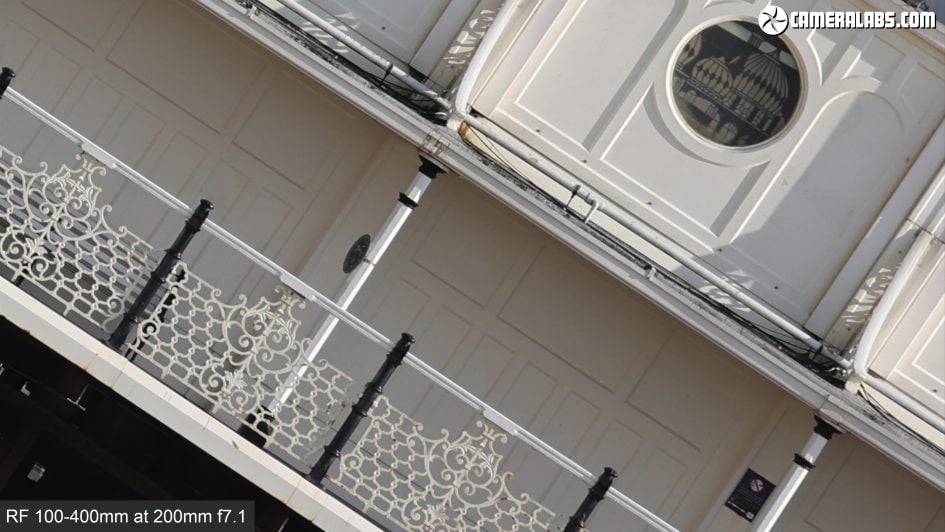
Above: Heading out to the corner shows the tiniest softening compared to the middle if you’re being super-critical, but to all intents and purposes it looks very similar. Closing the aperture one third of a stop to f8 makes no difference, while closing one stop further to f11 fractionally improves the sharpness, but again it’s barely visible under most situations.
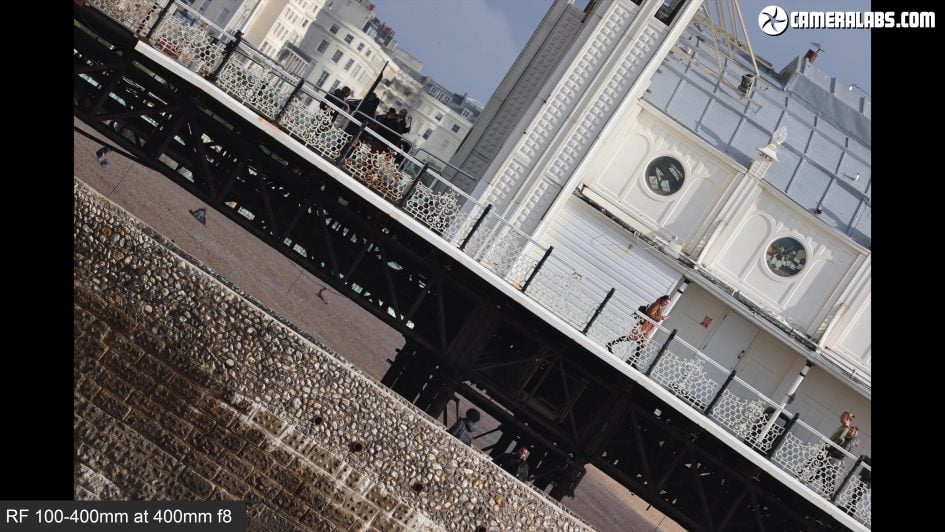
Above: And finally at the longest focal length of 400mm where the maximum aperture becomes f8.
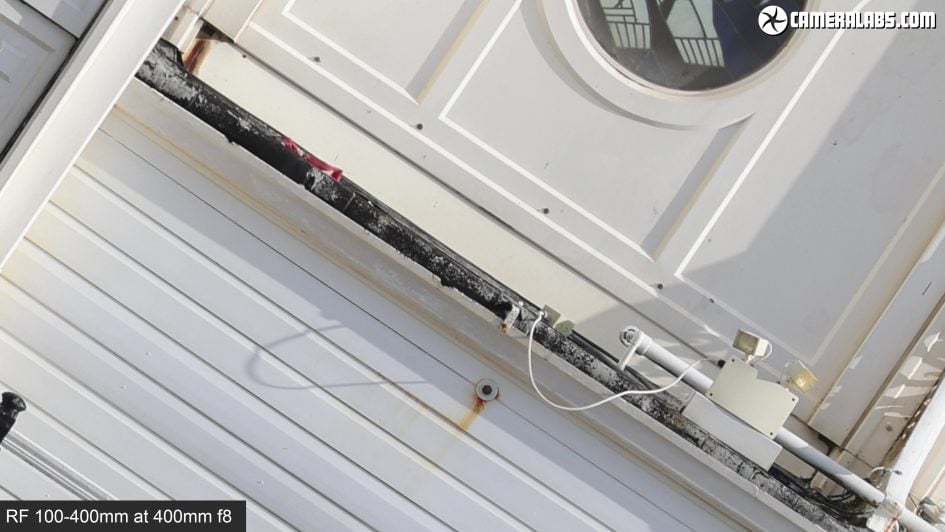
Above: Zooming-into the middle again shows the lens can capture fine details without issues and again there’s no benefit in the middle to stopping-down to f11.
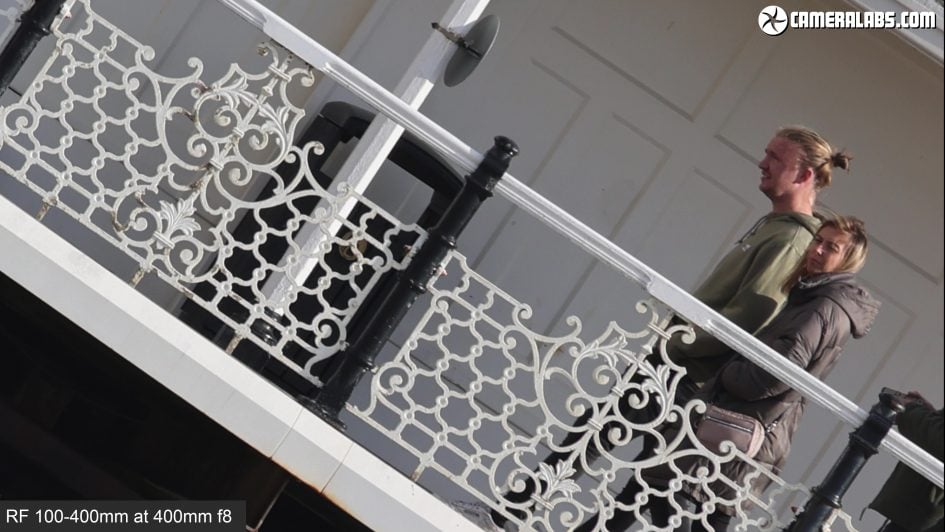
Above: Heading into the corners tells the same story as the shorter focal lengths: so a very minor softening, but really nothing to be concerned about, and little to no benefit to closing the aperture any further. But then at this point the lens is already at f8 with the aperture wide-open, so you wouldn’t really want to close it any further other than to boost the depth of field.
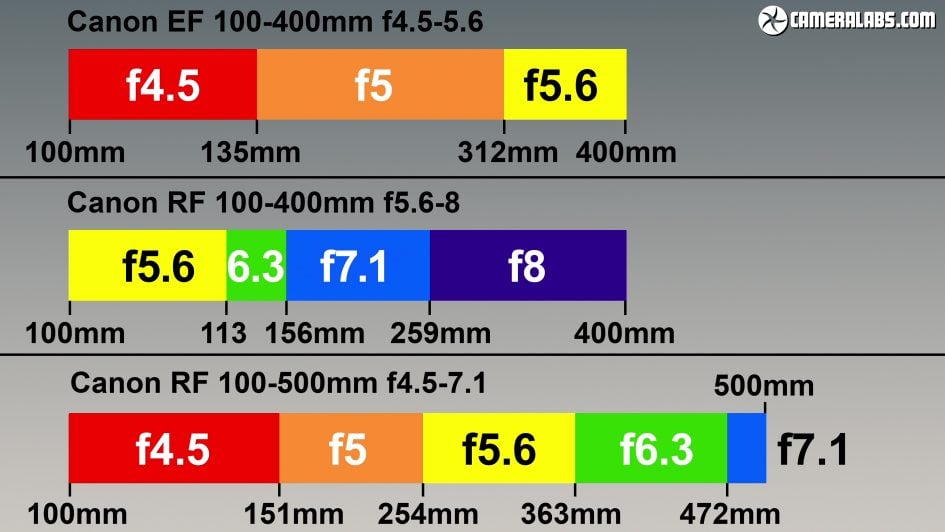
Above: As you know, the RF 100-400 has a variable aperture, starting at f5.6 at the short-end before dimming to f8 at the long-end, but one of the most revealing – and rarely discussed – specifications is exactly where in the range that aperture decreases. So I’ve measured it and made this lovely chart for you showing the aperture values for the old EF 100-400mm f4.5-5.6 at the top, the new RF 100-400 in the middle, and the RF 100-500 f4.5-7.1L at the bottom. So the new RF 100-400 starts at f5.6 and dims to f6.3 at 113mm, then to f7.1 at 156mm, then to its minimum f8 from 259mm to 400mm. So during this last section, it’s one stop slower than at 100-112mm. This makes the new RF zoom dimmer than the two L models, but it’s also considerably smaller, lighter and cheaper – in fact roughly one third the price of the EF 100-400 L and one quarter the price of the RF 100-500 L, so clearly it’s a completely different proposition.
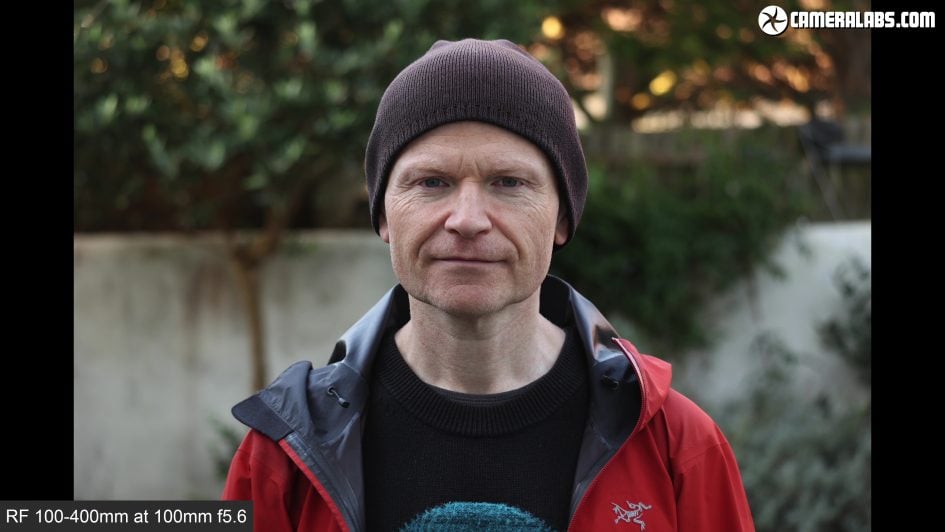
Above: Charts are important, but what you really want to know is how much blurring can you expect in the background with the maximum aperture at various focal lengths, so let’s start with a portrait taken on the EOS R5 with the lens at 100mm f5.6. The focal length is ideal for portraits with flattering perspective, but the fairly modest aperture means you’re never going to obliterate the background with blur. Taking a closer look though shows the lens can still capture sharp details of the subject at portrait distances, while the bokeh isn’t too busy or distracting.
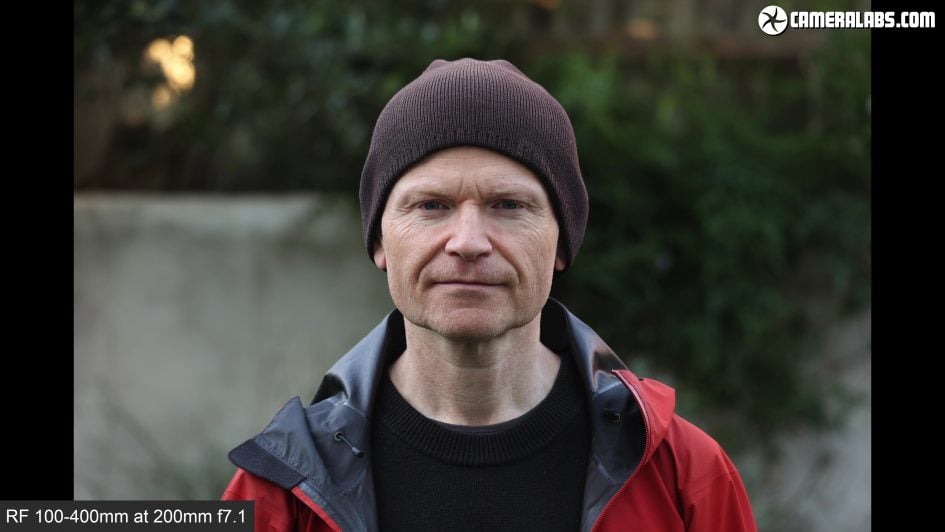
Above: Now for a version taken at 200mm f7.1 where I’ve moved away from the camera to roughly match the subject size. The longer focal length means less of the background is visible, although in this case with the wall being closer to me, the separation isn’t any better.
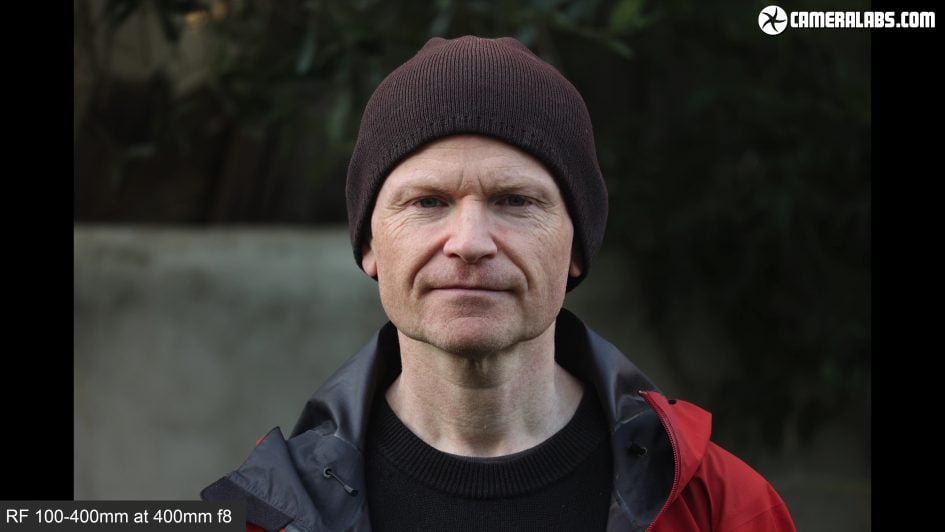
Above: And now at 400mm f8 for anyone brave or foolish enough to attempt a long telephoto portrait. Again the background blur is minimal, especially as I’m now positioned even closer to the rear wall, but zooming-in on my eyes shows there’s still good detail being captured which bodes well for sports and wildlife.
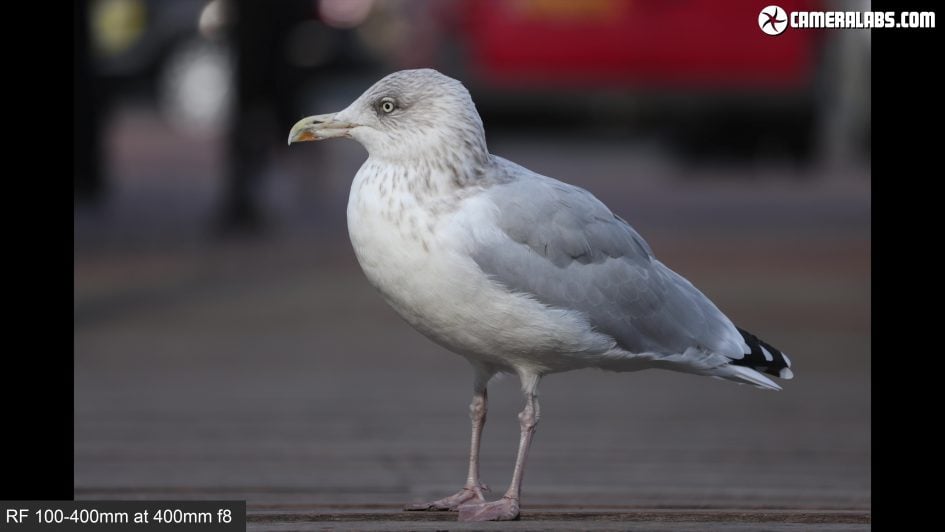
Above: so without further ado, let’s switch me for some true Brighton natives, all taken at 400mm f8 with the background more distant to achieve greater blurring. Here on the pier Steven Seagull is nicely separated from the background with very crisp details around the eye.
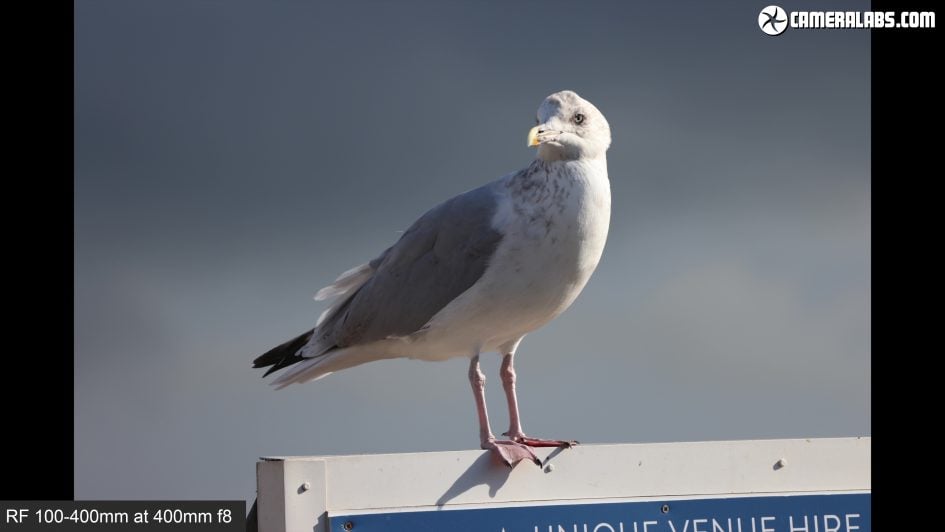
Above: Here’s another example where I’ve positioned myself so the background has become very distant, which in turn has rendered the Sea into a fairly uniform blur. Again taking a closer look shows very sharp details on the subject.
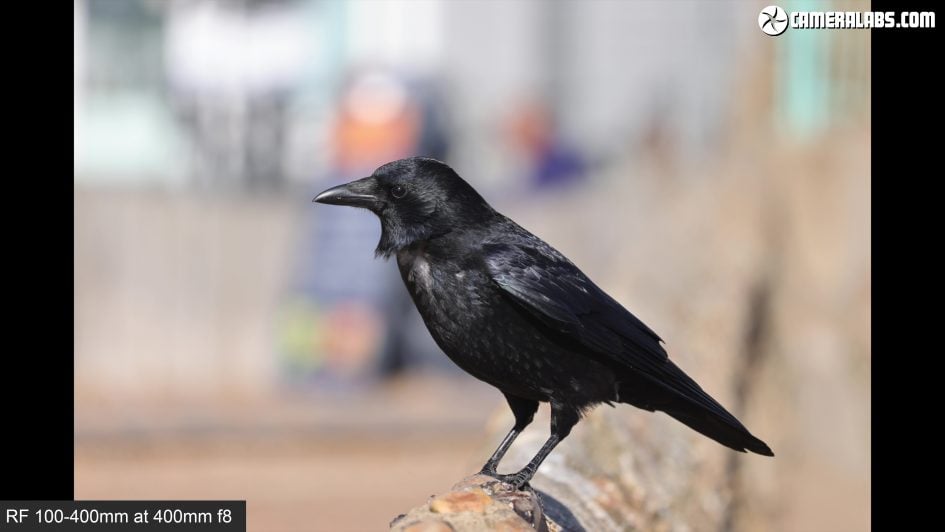
Above: And finally, is this a Crow? Either way, careful framing has allowed me to position the background as far away as possible, which has delivered some blurring even at f8…
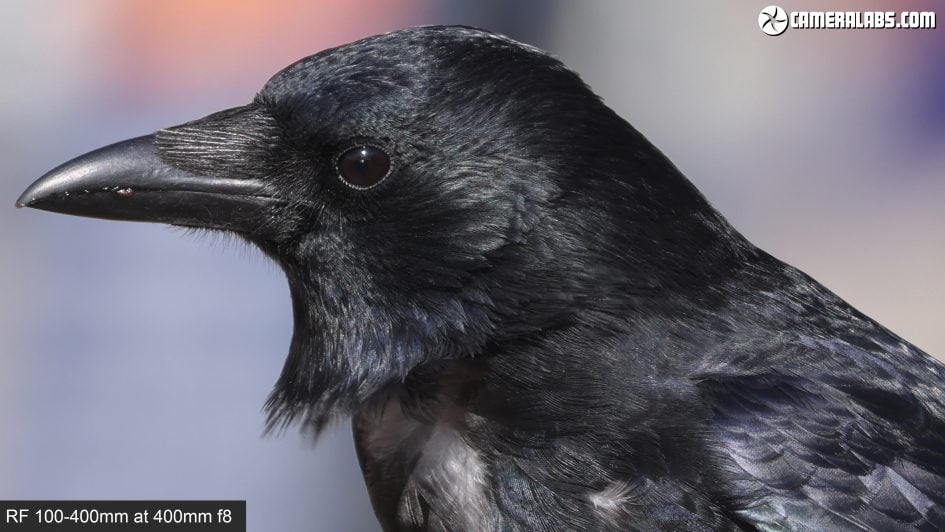
Above: …while taking a closer look at the subject shows the lens is capable of capturing very crisp details. These are all mostly static subjects though, so let’s see how well the lens auto-focuses.
I started with a single AF test on the EOS R5 using the 100-400 at 100mm and the maximum f5.6 aperture. It may be pitched as an affordable model, but by equipping it with Nano-USM motors, the 100-400 focuses very quickly, confidently and quietly too. Next for the lens zoomed to the longest 400mm end at the maximum f8 aperture, where it still manages to focus very quickly and accurately. So let’s translate that into real-life performance with some moving subjects.
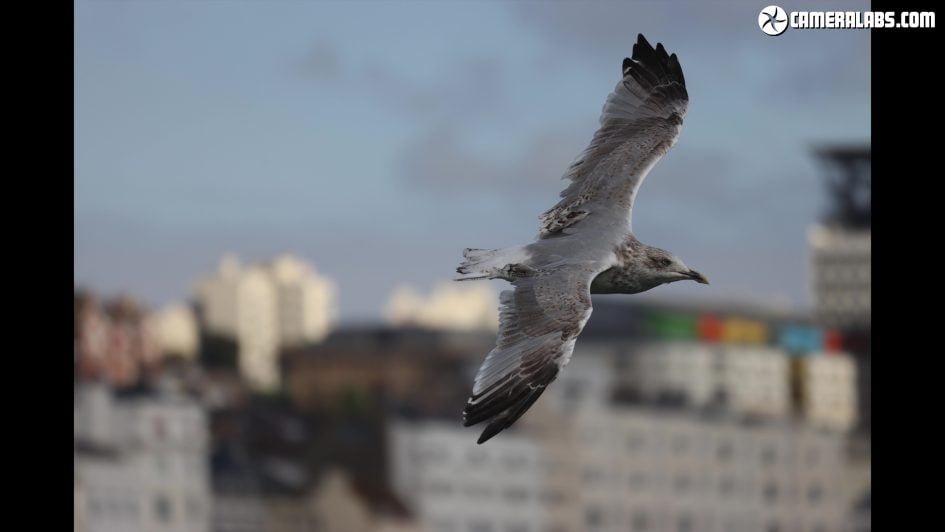
In my video review, you’ll see a selection of bursts I took of Brighton’s seagull population using the RF 100-400, mostly at 400mm and at the maximum aperture of f8. The lens was mounted on the EOS R5, using the full AF area with animal eye detection enabled and Servo for continuous autofocus. These are bursts using the mechanical shutter, delivering 10fps in practice here.
The combination of fast focusing motors driven by the R5’s bird eye detection allowed me to easily grab bursts of erratic seagulls with an almost 100% hit rate, making the RF 100-400 a very usable zoom for wildlife – and sports photography, at least under bright conditions. When zoomed to 400mm, the maximum aperture starts at f8, so if you want a fast shutter to freeze the action, you’ll need either bright conditions or a high ISO. Luckily the latest EOS R cameras are able to focus effectively at small apertures and in dim conditions, while their high ISO performance can look very respectable. I’m at peace with this personally but if you shoot under very dim conditions or desire the lowest ISOs or the shallowest depth-of-field, you’ll simply need to spend more on a heavier lens with a brighter aperture.
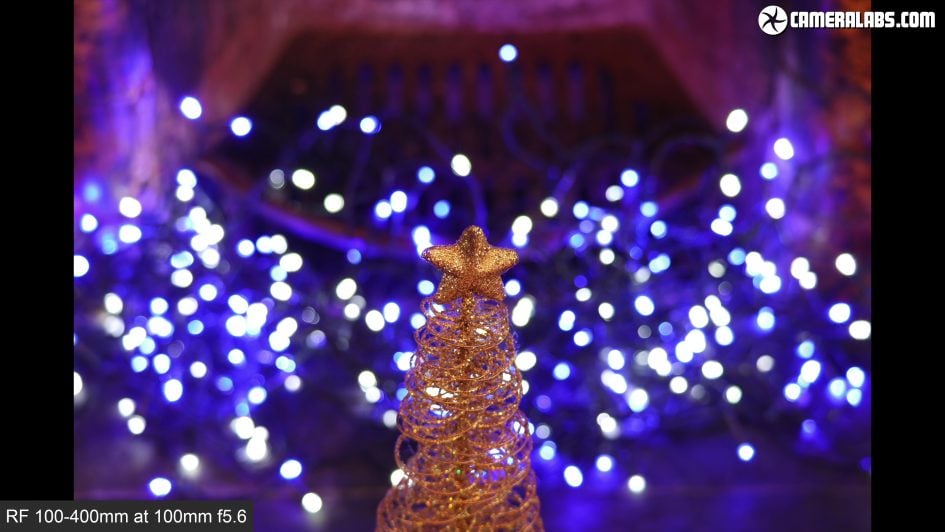
Above: Speaking of depth of field, you’ve already seen what’s possible at typical portrait and wildlife distances, but what about close-up? So here’s my bokeh ball test, first with the lens at 100mm f5.6 from its closest focusing distance, where you can see a little blurring on the LEDs in the background but unsurprisingly not a great deal. Taking a closer look at the blobs reveals a little outlining and mild textures within, so it’s not the classiest at rendering out-of-focus areas, but again not surprising given the specification. If you want larger and nicer-looking bokeh blobs at around this focal length, go for the RF 85mm f2 macro.
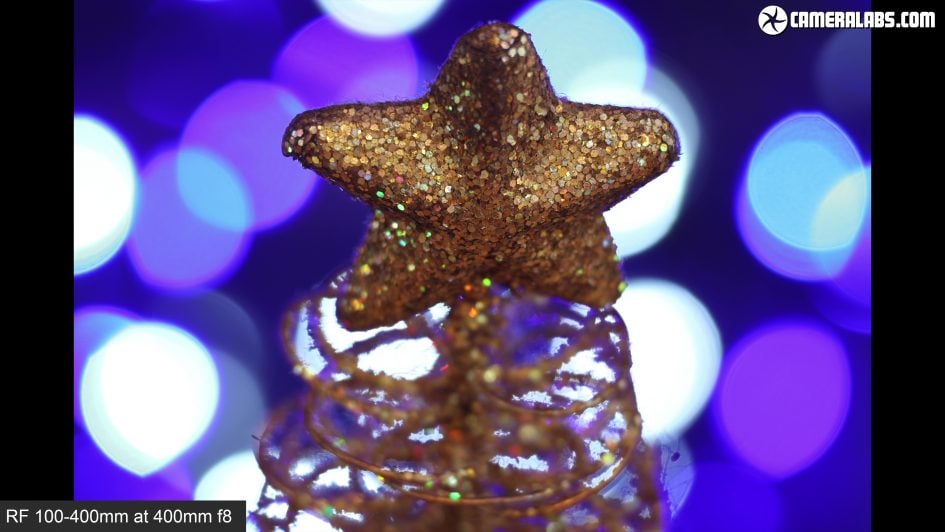
Above: That said, if you are able to frame your subject at 400mm, the lens can maintain the same focusing distance resulting in much larger bokeh balls as seen here, even at the maximum aperture of f8. They’re still far from perfect, but prove you can achieve some dramatic blurring if you’re careful how you shoot.
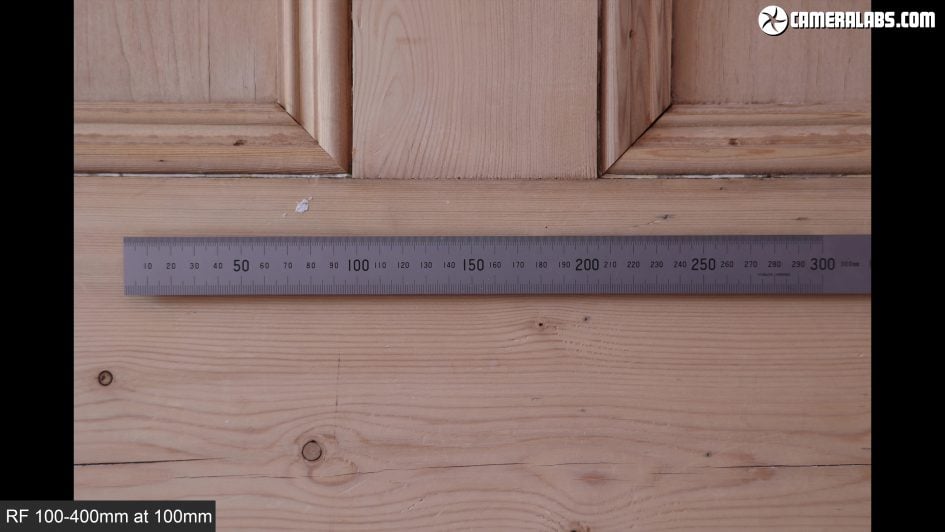
Above: When it comes to macro performance, the RF 100-400 appears to maintain the same closest focusing distance throughout its focal range. This results in quite modest reproduction at the short-end of 100mm as seen here, where the lens can’t even fill the frame with my 30cm ruler. I had to zoom to 113mm in order to reproduce 30cm across the frame. But by maintaining this closest focusing distance throughout its range, the reproduction keeps getting better the longer you zoom.
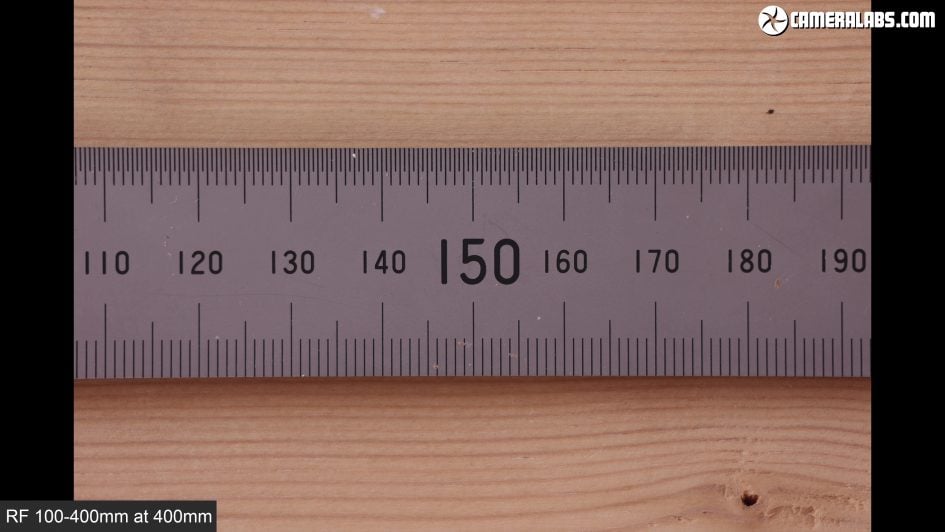
Above: So at the long-end of 400mm, I measured reproduction of 86mm across the frame. That’s still not amazing, but opens-up the possibility of capturing some smaller subjects – just make sure you zoom the lens in rather than attempting it at the shorter end. In my tests the lens also looked to be parfocal.
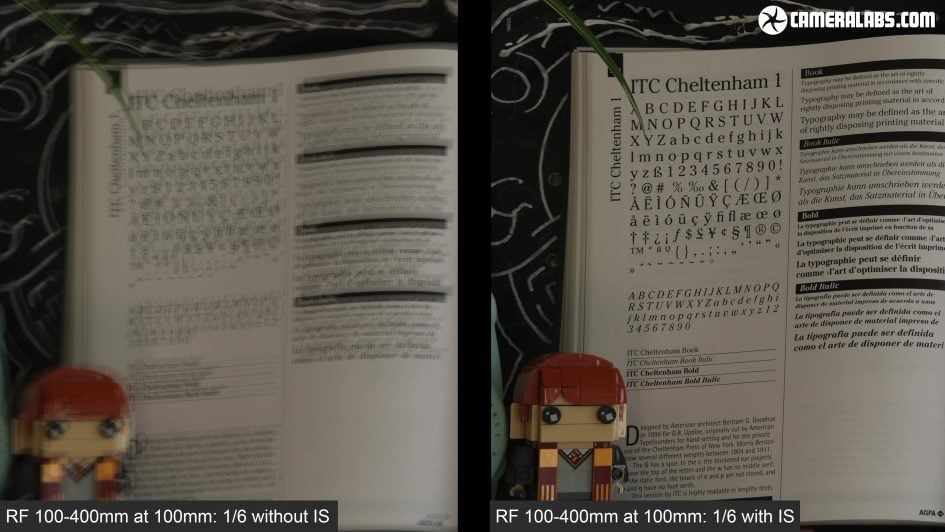
Above: Moving onto stabilisation, the RF 100-400 is equipped with optical IS that claims up to 5.5 stops of compensation on bodies without IBIS or up to six for those that do. At 100mm on the EOS R6 I needed a shutter speed of 1/200 for a sharp result without any stabilisation, versus 1/6 with IBIS and IS enabled, corresponding to five stops of compensation.
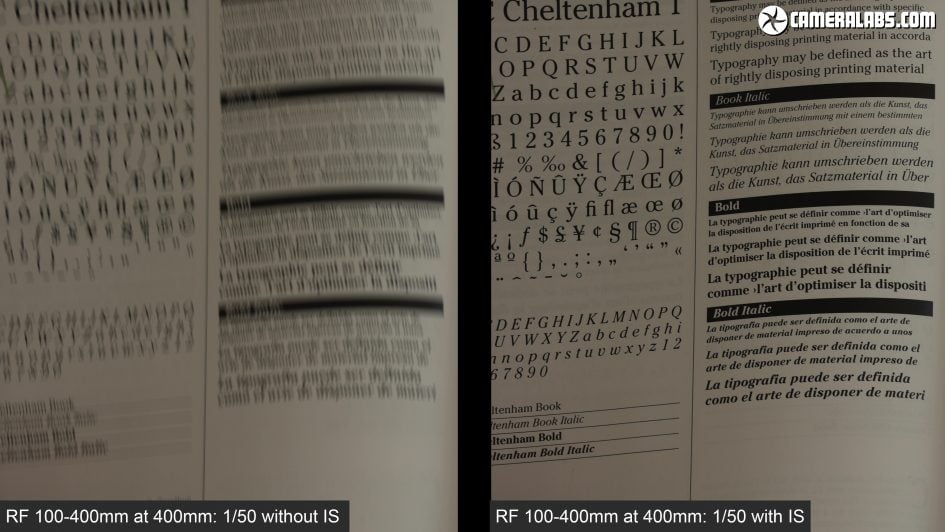
Above: At 400mm on the EOS R6, I needed a shutter speed of 1/400 for a sharp result without any stabilisation, versus 1/50 with IBIS and IS. While that worked out closer to three stops of compensation on the day, my results down to 1 /6 still looked pretty good.
While filming video, you’ll notice how it takes several seconds for the system to operate at its best, so if possible wait a moment before you need to take a shot or start the action. Even once the stabilisation was fully deployed though, I found it hard to handhold video at 400mm without some kind of support. Your mileage will of course vary.
Ok now for a quick focus-pulling test while filming video, first at 100mm f5.6 from the minimum focusing distance. Here there’s a minor pause as the camera reacts to the change of subject, after which the lens smoothly refocuses. If you glance at the background during the focus-pulls, you’ll also see there’s little to no breathing. Meanwhile zooming the lens to 400mm presents a greater challenge to the camera from the minimum distance, but it nails it most of the time.
From a more reasonable distance, here’s a face detection and tracking test at 100mm f5.6 – sorry about the slightly-off white balance here, that’s my fault, not the camera. In terms of focus though the EOS R system can easily drive the lens for presentations to camera, although as with my portrait stills tests, if you’d like a blurrier background, go for something like the 85mm f2 instead. What’s that, you want to see the same test at 400mm? Ok, here you go then, with the lens at 40mm f8, a completely impractical distance for presenting, but one the camera and lens can handle if you need to.
And finally before my verdict, a quick focus breathing test, starting with the RF 100-400 at 100mm f22, manually focusing from infinity to the closest distance and back again, where there is essentially no change at all to the magnification. And now at 400mm, where again there’s essentially no breathing, so no change in magnification as you focus. This is great news for anyone using the lens for videography, or indeed when manually focusing stills. The lens also appeared to be mostly parfocal too in my tests meaning it didn’t change focus as you zoomed through the range, so all-in-all, well-behaved in these regards.
Check prices on the Canon RF 100-400mm USM at B&H, Adorama, WEX UK or Calumet.de. Alternatively get yourself a copy of my In Camera book or treat me to a coffee! Thanks!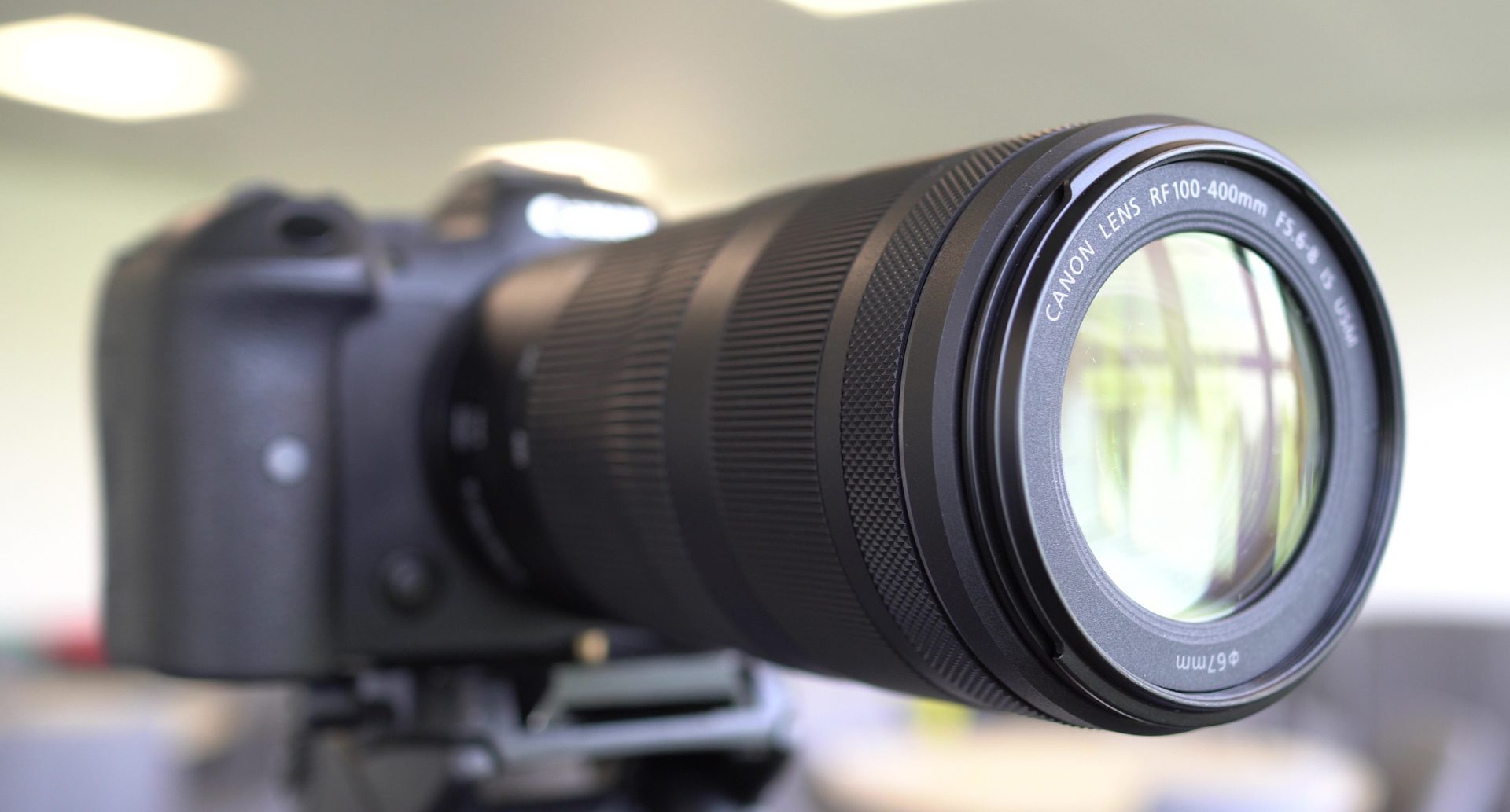
 The RF 100-400mm becomes Canon’s most affordable telephoto zoom for the EOS R system without adapting an older EF lens. The optical quality is excellent for the money with sharp results across the frame near and far, and at the maximum - albeit modest - apertures. Canon’s kept the price, size and weight low by deploying a fairly dim f5.6-8 aperture which means you won’t achieve much blurring unless you’re very close to the subject and if you need a fast shutter to freeze any action, you’ll also need to be shooting in good light or be at peace with high ISOs. As a lower-priced lens, the RF 100-400 also lacks weather-sealing and a lens hood in the box, although Canon hasn’t skimped on focusing which is fast enough to capture fast action and impressively lacks any breathing. It also works with the RF teleconverters throughout the zoom range. So while the RF 100-400 lacks the glamour of the EF 100-400 or RF 100-500, I’m pleased Canon’s producing a selection of more affordable, not to mention lighter, native RF lenses alongside its flagship L series. As such the RF 100-400 is easy to recommend if you want long-reach from a native RF zoom without breaking the bank or your back.
The RF 100-400mm becomes Canon’s most affordable telephoto zoom for the EOS R system without adapting an older EF lens. The optical quality is excellent for the money with sharp results across the frame near and far, and at the maximum - albeit modest - apertures. Canon’s kept the price, size and weight low by deploying a fairly dim f5.6-8 aperture which means you won’t achieve much blurring unless you’re very close to the subject and if you need a fast shutter to freeze any action, you’ll also need to be shooting in good light or be at peace with high ISOs. As a lower-priced lens, the RF 100-400 also lacks weather-sealing and a lens hood in the box, although Canon hasn’t skimped on focusing which is fast enough to capture fast action and impressively lacks any breathing. It also works with the RF teleconverters throughout the zoom range. So while the RF 100-400 lacks the glamour of the EF 100-400 or RF 100-500, I’m pleased Canon’s producing a selection of more affordable, not to mention lighter, native RF lenses alongside its flagship L series. As such the RF 100-400 is easy to recommend if you want long-reach from a native RF zoom without breaking the bank or your back.



